The Rookery One of the earliest remaining skyscrapers, this 1888 Chicago landmark combines traditional wall-bearing and newer steel frame construction.
The latter made it possible for its architects, Burnham and Root, to
design an open interior, with office spaces set around a central light
well.
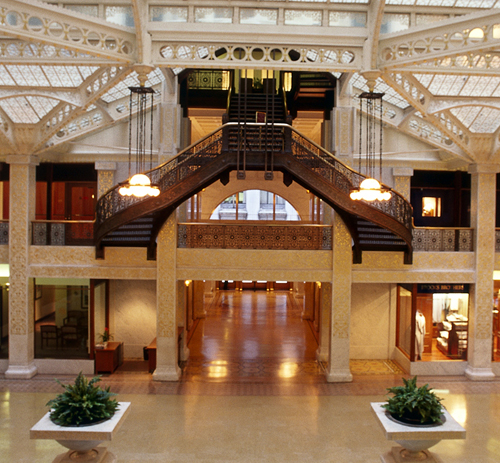
The Rookery
Auditorium Theatre Built
by Adler and Sullivan in 1889, the ornate Auditorium also originally
contained a hotel and office building and had one of the first public
air-conditioning systems. The revamped 4,000-seat theater boasts
near-perfect acoustics.
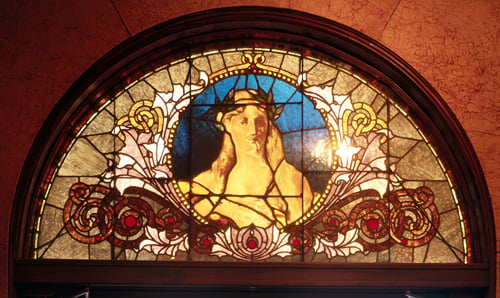
Art glass, Auditorium Theatre
Monadnock Building Constructed
in two stages, this Loop edifice represents the evolution of skyscraper
architecture. The northern half was built in 1891 using solely
wall-bearing construction, while the southern half was built two years
later and incorporated the then emerging steel-frame technology that is
still used today .
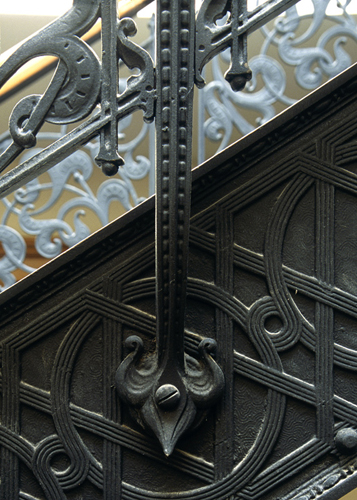
Detail of staircase, Monadnock Building
Reliance Building The
steel skeleton on this 1895-built skyscraper allowed it to be wrapped
in glass. It offers an excellent example of the Chicago window, which is
characterized by a bay window placed between two narrow, double-hung
windows – a signature feature of the Chicago school of architecture.
Occupied by the Hotel Burnham the interior sports replicas of original features . 860–80 N. Lakeshore Drive You
might think these two highrise apartment buildings (1949–51) look like
many others along this tony strip. Actually, the others look like these.
German architect Mies van der Rohe perfected the “less is more”
approach which so many other architects went on to copy.
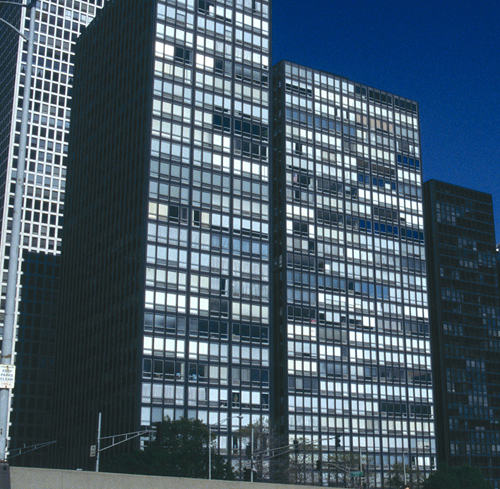
860–80 N. Lakeshore Drive
Marina City With
its twin cylindrical structures (1959–64) on the Chicago River, Marina
City is a “city within a city,” containing offices, residences, a
theater, a grocery store, and more. The apartments start on the 21st
floor, affording spectacular views, but their slice-of-pie shape creates
some interior decorating challenges. Sears Tower This
soaring tower, built in 1974 as the headquarters of retailer Sears
Roebuck and Co. (who have since moved out), can be seen from almost
anywhere in the city. Its Skydeck affords sensational views . 333 W. Wacker Drive The
graceful curve of this triangular, tinted-glass office building (1983)
hugs the Chicago River. The water, together with the changing light and
clouds create dynamic reflections: the green and silver lobby continues
the shimmering show.
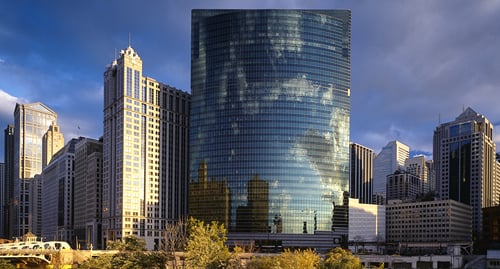
333 W. Wacker Drive
James R. Thompson Center From
inside the circular atrium of this magnificent 17-story building
(1985), a quick glance up is almost dizzying. Take the elevator to the
top for an impressive view of the stunning marble rosette on the
concourse level . Ogilvie Transportation Center Rising
40 stories in waves of glass and steel is this striking 1996-rebuilt
commuter train station (aka the Northwestern Station). Its streamlined
façade mimics a vintage luxury train.
Top 10 Architects
William Le Baron Jenney The “father of the skyscraper” (1832–1907) who designed the first all-metal-framed structure in 1885. Daniel Burnham Visionary city planner and architect, Burnham (1846–1912) was the man behind the White City . William Holabird & Martin Roche This influential team (Holabird 1854–1923; Roche 1855–1927) developed early Chicago-style skyscrapers including the Marquette Building. Louis H. Sullivan The creator (1856–1924) of the “form follows function” doctrine designed according to a building’s intended use. Frank Lloyd Wright Inspired by the wide open spaces of the Midwest, Wright was the originator of the Prairie style. George Maher A Prairie School architect (1864–1926) who favored Arts and Crafts motifs. Walter Burley Griffin Another Prairie–style architect (1876–1937) with a namesake historic district on Chicago’s Southside. Ludwig Mies van der Rohe Minimalist architect (1886–1969) and creator of the modern glass-and-steel box. Bertrand Goldberg A pupil of Mies van der Rohe who rebelled to produce curvilinear concrete shapes. Harry Weese A Modernist (1915–98), but one sympathetic to existing buildings of merit.
|